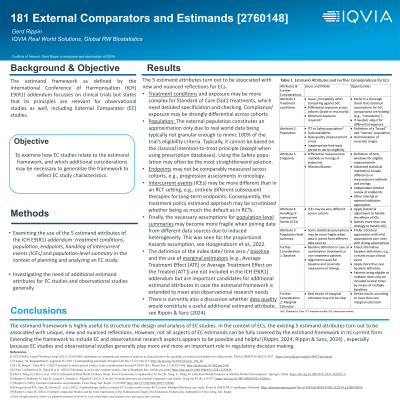Methods
Session: Poster Session B
(181) External Comparators and Estimands
Tuesday, August 27, 2024
8:00 AM - 6:00 PM CEST
Location: Convention Hall II


Gerd Rippin, Dr.
Senior Director, Biostatistics
IQVIA
Frankfurt, Germany
Presenting Author(s)
Background: The estimand framework as defined by the International Conference of Harmonisation (ICH) E9(R1) addendum was set up by focusing on clinical trials but states that its principles are relevant for observational studies as well.
Objectives: To examine how External Comparator (EC) studies relate to the estimand framework and which additional considerations may be necessary to generalize the framework to reflect EC study characteristics.
Methods: The 5 estimand attributes of the ICH E9(R1) addendum: treatment conditions, population, endpoints, handling of intercurrent events (IEs) and population-level summary are examined one by one in the context of planning and analyzing an EC study.
Results: The 5 estimand attributes turn out to be associated with new and nuanced reflections for ECs and observational research in general. Specifically, treatment conditions and exposure may be more difficult to handle, and especially Standard of Care (SoC) treatment needs detailed attention. The external population typically cannot be based on the classical intention-to-treat principle and constitutes an approximation due to RW data being typically not very granular for enabling to mimic 100% of the trial’s eligibility criteria. Endpoints may not be comparable across cohorts, and intercurrent events may be more different than in an RCT setting. Finally, the necessary assumptions for population-level summaries (e.g., the proportional hazards assumption) may become more fragile when joining data from different sources due to induced heterogeneity. The definition of baseline and the use of marginal estimators are not included in the ICH E9(R1) guideline but are important candidates for additional estimand attributes in case the estimand framework is decided to describe also observational research aspects.
Conclusions: The estimand framework is highly useful to structure EC studies and pharmacoepidemiological research generally, though not all aspects can be fully covered by the estimand framework in its current form. Extending the framework to include more observational research aspects appears to be possible and helpful, especially because EC studies and observational research play more and more an important role in regulatory decision making.
Objectives: To examine how External Comparator (EC) studies relate to the estimand framework and which additional considerations may be necessary to generalize the framework to reflect EC study characteristics.
Methods: The 5 estimand attributes of the ICH E9(R1) addendum: treatment conditions, population, endpoints, handling of intercurrent events (IEs) and population-level summary are examined one by one in the context of planning and analyzing an EC study.
Results: The 5 estimand attributes turn out to be associated with new and nuanced reflections for ECs and observational research in general. Specifically, treatment conditions and exposure may be more difficult to handle, and especially Standard of Care (SoC) treatment needs detailed attention. The external population typically cannot be based on the classical intention-to-treat principle and constitutes an approximation due to RW data being typically not very granular for enabling to mimic 100% of the trial’s eligibility criteria. Endpoints may not be comparable across cohorts, and intercurrent events may be more different than in an RCT setting. Finally, the necessary assumptions for population-level summaries (e.g., the proportional hazards assumption) may become more fragile when joining data from different sources due to induced heterogeneity. The definition of baseline and the use of marginal estimators are not included in the ICH E9(R1) guideline but are important candidates for additional estimand attributes in case the estimand framework is decided to describe also observational research aspects.
Conclusions: The estimand framework is highly useful to structure EC studies and pharmacoepidemiological research generally, though not all aspects can be fully covered by the estimand framework in its current form. Extending the framework to include more observational research aspects appears to be possible and helpful, especially because EC studies and observational research play more and more an important role in regulatory decision making.
